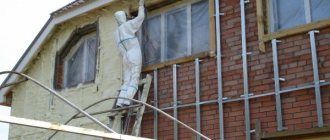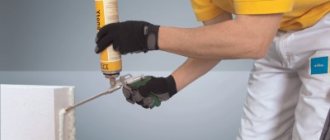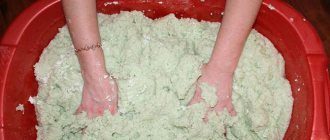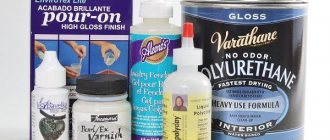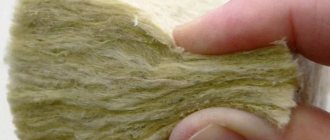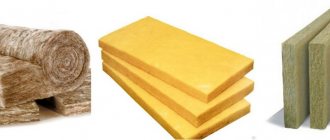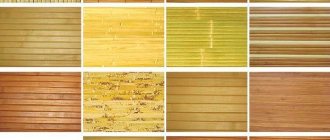Pros and cons of using foam
Before deciding to insulate the walls of your house with foam, you need to consider all the advantages and disadvantages of the method. Among the positive features are the following:
- High speed of application, ability to process large surfaces in one approach.
- High resistance of the material to biological factors - insects, mold, fungi, putrefactive bacteria.
- Insulation with pressurized foam from a special sprayer allows you to fill all the smallest cavities and create a seamless coating with a high level of thermal insulation.
- When hardened, the foam composition has a very low specific gravity and therefore does not increase the load on the load-bearing structures of the building.
- The application technology eliminates the use of special fasteners - it simply sticks when sprayed onto the surface.
- The compounds in cured foam are completely safe and non-toxic.
Applying foam from inside a frame house Source ast75.ru
- Simple installation procedure.
- Increased sound insulation of insulated surfaces.
- Contact of foam with pipes, frame elements, roofing sheets and other metal products does not cause a destruction reaction of the latter, but, on the contrary, creates effective anti-corrosion protection.
- Refractory material, does not support active combustion.
But we must take into account some of the disadvantages of foam insulation:
- The total cost of thermal insulation with foam is at least 2 times more expensive than using conventional thermal insulation materials.
- Destruction of the structure due to prolonged contact with water, high air humidity and exposure to direct rays of the sun.
- Insulating a roof with foam, as well as walls, and any other surface of a large area, will require the use of high-performance equipment, which involves additional costs.
- The worker performing the spraying must wear a personal protective suit.
Important! Foam is one of the modern insulation materials that allows you to reliably insulate a house quickly and without additional costs. However, one of the significant disadvantages of a foamed surface is the violation of vapor permeability. Therefore, both inside the building itself and in the insulated elements, it is necessary to provide in advance an effective ventilation and vent system.
Using a protective suit during spraying Source ppuspb.ru
See also: Catalog of companies that specialize in home insulation
Types of materials
Foam insulation for walls exists in the following main modifications:
- Penoizol.
Foaming components based on aldehydes and urea polymers. Complete hardening time is about 3 days. Available both in aerosol cans for spraying and in the form of ready-made slabs or granules. It is used for filling cavities when insulating floors, ceilings and walls.
- Polyurethane foam.
PPU is a two-component insulation foam. Immediately before use, the ingredients are mixed into one mixture. This is the most commonly used universal foam material. When the filler is formed, a mass with closed air voids is formed 40 times greater than the original volume.
Polyurethane foam does not absorb moisture, exhibits good adhesion to any materials and is not affected by rodents. Can be used for both external and internal application.
Application of polyurethane foam Source zbbr.ru
- Polyurethane foam.
Based on a modification of polyurethane. Increases in volume from the original by 20 times. It is used from cans for sealing small cavities - when installing windows, doors, pipes, seams, etc.
- Foam concrete.
It is used for pouring and thermal insulation of foundations and reinforced concrete floors. Insulating walls with foam based on concrete mortar is not recommended due to its significant mass and the resulting excessive load on load-bearing structures. Available in both liquid and ready-made block form.
Recommendation! PPU roof insulation creates a reliable heat-insulating coating with little load on the frame. The foam has high adhesion and is applied directly to the inner surface of roofing sheets. At the same time, sufficient thermal insulation can be achieved with a layer of only 5-7 cm.
Roof insulation from the inside using polyurethane foam Source ppuspb.ru
Types of sprayed polyurethane foam
Polyurethane foam insulation, which is applied by spraying, is divided into two categories: industrial - sold in barrels and used by specialists to insulate large structures and surfaces, and in 1-liter cylinders, which are intended for independent use. Industrial polyurethane foam is represented by several brands from different manufacturers.
The most famous are:
- Sealection 500 is an American made material. It has an open structure and fire safety class G2.
- “Ecotermix” is produced on the basis of vegetable oils and contains a minimum amount of harmful substances. There are two varieties of it on sale: grade 300 - with a closed structure to protect external surfaces from cold, and grade 600 - with an open structure for interior work.
- Healtok Soy 200 is a closed-structure insulation material made from soybean oil and polymer waste. Adheses perfectly to any surface, tightly fills all cracks and pores.
Polyurethane foam in cylinders is made from polymer components. The can has a spray tip or adapter for use with a mounting gun. Currently, this insulation is represented on the market by two brands - Polinor and TEPLIS. The material looks like polyurethane foam. After hardening, it forms a fine-mesh coating with low thermal conductivity. One cylinder is enough for 1 sq. m of surface when applied in a layer of 40 mm.
The application technology is simple:
- Surfaces must be cleaned of dust and dirt and slightly moistened.
- You need to screw the nozzle onto the cylinder.
- Then it is shaken and the nozzle is directed to the desired location.
- By pressing the trigger of the gun, the material is sprayed.
Currently, insulation in cylinders is heavily advertised, but experts do not advise trusting advertising too much.
Manufacturers of industrial two-component insulation believe that one-component polyurethane foam in cylinders is practically no different from conventional polyurethane foam, but costs several times more. The material has a large number of open pores, therefore it is unsuitable as a hydro- and vapor barrier.
Therefore, if you decide to properly insulate your home, you should not rely on unprofessional insulation. If you wish, you can use a spray can to treat small areas of structures or internal partitions, but it is hardly suitable for insulating large surfaces.
Area of use, recommendations for selection
Construction foam is a universal insulation material. However, due to some differences in the properties of various compositions, it is better to use a specific variety in one case or another. For this there are the following series of recommendations:
- Cracks, defects, and cavities during the installation of windows and doors are sealed with polyurethane. In this case, the frozen material must be protected from direct sunlight.
- Filling the large inter-wall volume of frame structures is carried out using penoizol. Used both externally and internally to form an insulating seal in walls and floors between sheathing sheets.
- Elimination of small-sized irregularities, cracks, seams, and cavities is done using polyurethane foam. For example, when installing solid insulating panels, arranging a foundation, installing windows.
Sealing defects with polyurethane foam Source yandex.net
Polyurethane liquid foam for insulating walls, attics, roofs, and basements creates reliable protection with good waterproofing performance. Spraying is carried out using special equipment. However, if the volume of similar work is small, then it is quite acceptable to use polyurethane foam from cylinders.
Methods for insulating a main wall
Foam for walls is used to insulate structures in two variations:
- Outside.
- From the inside.
- Combined.
In the first case, the wall material is reliably protected from external atmospheric manifestations. In this case, the zone of condensation formation is shifted into the insulating mass, and not into the wall structure. Therefore, it is reliably protected from destruction under the influence of dampness - rotting and expansion of ice when freezing. In this way, a balance is maintained - heat is retained in the house and the durability of the structure is ensured.
When houses are insulated with foam from the inside, the point of condensation formation moves directly into the wall material. Despite maintaining heat in the room, the material will always be damp. Therefore, in summer it will be susceptible to rotting, and in winter it will be subject to destruction due to expansion during freezing of water.
What is the best way to insulate with foam - from the outside or from the inside?
Thermal insulation with foam has several nuances. It is impossible to take and close all the holes, since then the level of humidity in the room will increase, which will negatively affect the insulation process. For example, the walls will begin to collect condensation and become wet over time, which will certainly affect the performance of the house.
The method of insulation from the inside or outside of the house is largely dependent on what material the walls are made of. If it is a brick, then it is recommended to insulate the structure from the outside using a sandwich scheme, that is, you need to put a layer of insulation between two bricks. Since it has insulating properties, it provides a space with double the effect and warms the rooms in the house with minimal need for additional heating.
In the case of concrete walls, craftsmen use insulation under the drywall during repairs. However, there is always the possibility that improper filling of voids with foam will lead to the formation of a cold bridge. Due to the loose fit of the material, cold street air will penetrate into the house.
Before you decide whether to insulate your home from the outside or inside, you need to determine the dew point. The closer it is to the parameters of the actual humidity temperature in the rooms, the higher the risk that internal insulation will provoke the appearance of wet spots on the walls. This point is calculated by comparing atmospheric pressure, relative and actual temperature conditions.
Do-it-yourself insulation
To make high-quality thermal insulation of a house with foam, while ensuring the safety of the wall material with a guarantee, only a real professional team can do. For those who decide to perform the procedure themselves, we can recommend the following instructions:
- The sheathing is screwed or nailed to the outer sides of the house wall. The slats, 2-3 cm thick and 7-10 cm high, are mounted edge-to-plane. Horizontal and vertical crossbars should form hollow cells with dimensions of 0.5 by 0.5 meters.
- Before starting work, the user puts on a protective suit, gloves, goggles, and a respirator.
Insulation of walls with polyurethane foam Source stroy-podskazka.ru
- The spraying equipment is brought into readiness, the container is filled (foam for wall insulation in cylinders is connected to the gun), its serviceability and performance are checked.
- The cavities of the sheathing are filled from edge to center with foam, taking into account its subsequent expansion - in full accordance with the instructions from the manufacturer.
- Upon completion of the work, the material is given time to completely harden.
- The frozen mass is leveled and finished with panels, sheet materials or plaster.
It is important to know! The choice of modification and foam manufacturer depends on the preferences, conditions of use and financial capabilities of the individual user. For example, you can simply foam the walls of your house with polyurethane foam. However, before starting work, it is recommended to find out as much information as possible about the composition used - from the seller, on the manufacturer’s website, in reviews, from craftsmen. It is better to give preference to a more reliable, safe and high-quality composition.
Which liquid insulation to choose?
As is known, long-term or improper storage significantly worsens the properties of materials, especially liquid insulation. In this regard, when choosing a composition, you should first of all pay attention to the date of its manufacture. In addition, it is recommended to give preference to well-known brands that have proven themselves, because the effectiveness of the entire thermal insulation system depends on the quality of the liquid insulation.
In order to ensure the quality of liquid insulation produced in the form of paint, experts recommend:
- Check the weight of the bucket - the lower the density of the composition, the higher its heat-saving properties. Therefore, if a ten-liter plastic bucket weighs more than 6.5 kilograms, then you should not purchase such a composition.
- Check the paint against light, as light microspheres rise up. Therefore, the thicker the top layer of insulation, the better its thermal insulation characteristics.
- Rub a small amount of paint with your fingertips - a good material should feel a large number of rough microgranules. The absence of such an effect indicates low quality of the product.
- Make sure the composition is white - a change in color indicates gross violations of the technological process. However, this rule does not apply to paints with mineral color additives.
It should be noted that in this case you should not focus on the cost of the product, since some manufacturers deliberately sell low-quality products at inflated prices in the hope that the choice stereotype will be triggered.
Briefly about the main thing
Insulating a house with foam has the following number of advantages:
- No load on structures.
- Seamless and hermetic filling of cavities.
- Biological resistance.
- Fire safety.
- Harmlessness.
- Creation of anti-corrosion protection for metal elements.
- Simple application procedure.
Disadvantages - high cost, low water resistance and sun protection, the need to use a protective kit during spraying. The most common types of foam insulation are penoizol, polyurethane foam, polyurethane foam and foam concrete.
The materials can be used both in liquid form and in the form of finished panels and blocks. The main purpose is to seal cracks and cavities, fill frame walls, insulate roofs, basements, floors, and facades. Thermal insulation can be done independently according to the instructions, but it is better to entrust the procedure to professionals.
Ratings 0
Other advantages
- The hardened structure of the material with pores also seems to be an excellent material for sound insulation.
- The material is light enough, it will not exert any noticeable load on building structures.
- Many of these insulating materials, after final polymerization, become completely safe for people, animals and nature. They do not become infected with fungi or mold, and they are not of interest to mice, rats or insects.
- Most of the insulating foam has excellent contact with the structural and metal elements of the building, not only forms a thermal insulation layer for them, but also creates good protection against rust. Most materials of this type exhibit excellent waterproofing properties, preventing vapor or water from penetrating. When insulating walls, roofs or ceilings, it eliminates the need to install special gaskets.
